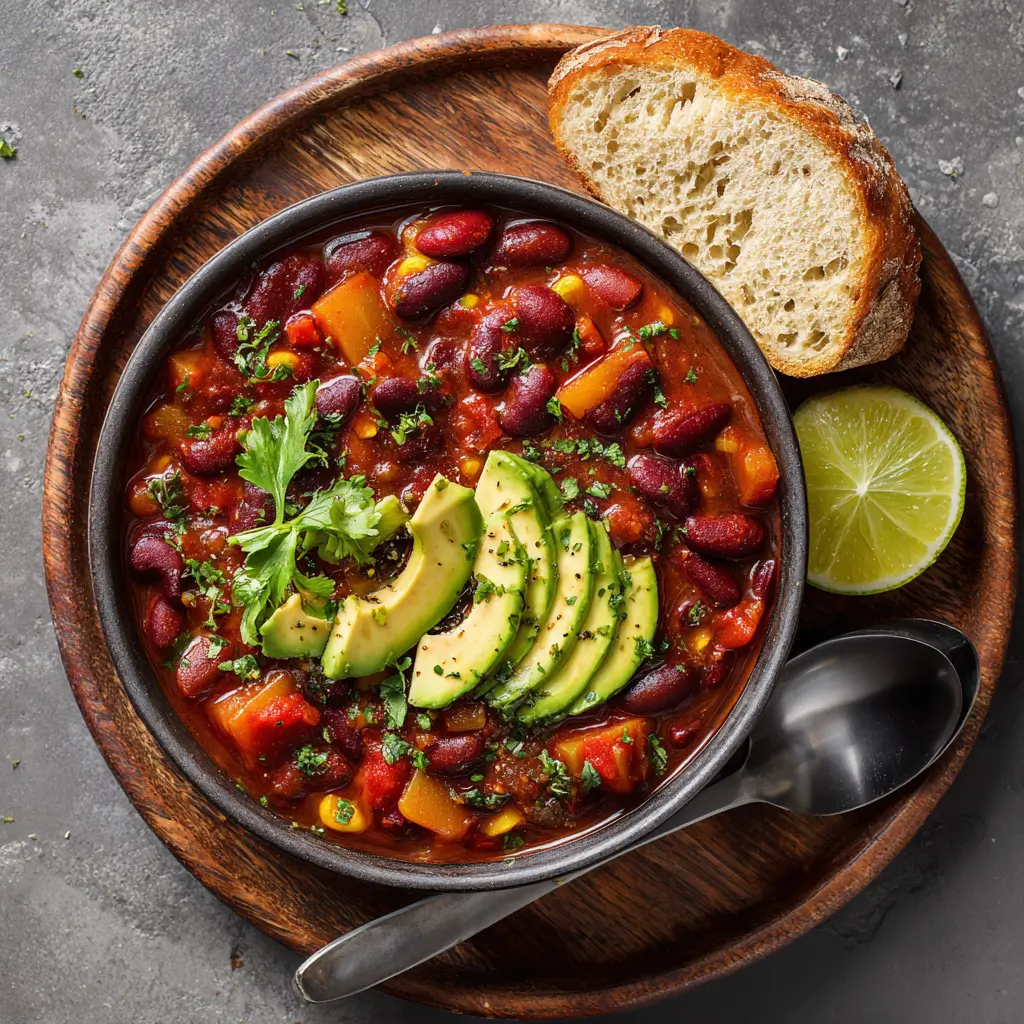Introduction
Vegetarian Chili with Avocado is a hearty, wholesome dish that combines the bold flavors of traditional chili with the creamy richness of fresh avocado. This plant-based delight is perfect for anyone looking to enjoy a satisfying meal without meat, while still getting plenty of protein, fiber, and essential nutrients. Whether you’re a committed vegetarian or simply exploring more meatless meals, this recipe offers a delicious way to celebrate vegetables, legumes, and spices in harmony. The addition of ripe avocado not only enhances the texture but also contributes heart-healthy fats and a cooling contrast to the warm, spicy chili.
The History
Chili, or chili con carne, has deep roots in Tex-Mex cuisine, believed to have originated in San Antonio, Texas, during the 18th or 19th century. Traditionally made with beef, chilies, and beans, chili became a staple of Southwestern American cooking. Over time, variations emerged as people adapted the dish to suit dietary preferences and regional ingredients. The vegetarian version gained popularity in the late 20th century, especially with the rise of health-conscious eating and the growing interest in plant-based diets. Adding avocado to chili is a modern twist inspired by Mexican culinary traditions, where avocados are frequently used in salsas, salads, and as garnishes. Today, Vegetarian Chili with Avocado stands as a celebration of flavor, nutrition, and cultural fusion, bridging old-world techniques with contemporary wellness trends.
Ingredients Breakdown
The magic of Vegetarian Chili with Avocado lies in its diverse and nutrient-rich ingredients, each contributing unique flavors, textures, and health benefits:
- Beans: A trio of kidney beans, black beans, and pinto beans provides a robust source of plant-based protein and fiber, helping keep you full and energized.
- Tomatoes: Diced tomatoes and tomato paste form the rich, tangy base of the chili, offering lycopene—an antioxidant linked to heart health.
- Vegetables: Onions, bell peppers, garlic, and corn add sweetness, crunch, and a spectrum of vitamins including vitamin C and beta-carotene.
- Spices: Chili powder, cumin, smoked paprika, oregano, and cayenne pepper create the signature warmth and depth, enhancing flavor without excess sodium.
- Liquid Base: Vegetable broth ensures a savory depth while keeping the dish vegan-friendly and hydrating.
- Avocado: Freshly diced avocado stirred in at the end adds creaminess, healthy monounsaturated fats, and a buttery texture that balances the heat.
- Optional Add-ins: Lime juice, cilantro, green onions, and jalapeños elevate freshness and brightness.
This carefully balanced combination results in a dish that’s as nutritious as it is delicious.
Step-by-Step Recipe
- Sauté the Aromatics: In a large pot or Dutch oven over medium heat, add 2 tablespoons of olive oil. Once shimmering, add 1 diced onion, 1 diced red bell pepper, and 3 minced garlic cloves. Sauté for 5–7 minutes until softened and fragrant.
- Add Spices: Stir in 2 tablespoons chili powder, 1 tablespoon ground cumin, 1 teaspoon smoked paprika, 1 teaspoon dried oregano, and ½ teaspoon cayenne pepper (adjust to taste). Cook for 1 minute to toast the spices, releasing their essential oils.
- Incorporate Tomatoes: Pour in one 28-ounce can of crushed tomatoes and one 15-ounce can of diced tomatoes (with juices). Add 2 tablespoons of tomato paste and stir well to combine.
- Add Beans and Broth: Drain and rinse three 15-ounce cans of beans—kidney, black, and pinto—and add them to the pot. Pour in 2 cups of vegetable broth to achieve a stew-like consistency.
- Simmer: Bring the mixture to a boil, then reduce heat to low. Cover and simmer for 30–45 minutes, stirring occasionally, allowing the flavors to meld and deepen.
- Add Corn: Stir in 1 cup of frozen or canned corn kernels during the last 10 minutes of cooking.
- Season: Taste and adjust seasoning with salt and black pepper. A splash of apple cider vinegar or lime juice can brighten the flavors.
- Prepare Avocado: Just before serving, dice 1–2 ripe avocados and gently fold into the chili or use as a topping to maintain texture.
- Serve: Ladle hot chili into bowls and garnish with fresh cilantro, green onions, shredded cheese (optional), and a wedge of lime.
Tips
- Toast the Spices: Always cook your spices for 30–60 seconds after adding them to the aromatics. This “blooms” the spices, intensifying their flavor.
- Use Fire-Roasted Tomatoes: Opt for fire-roasted diced tomatoes for a smoky depth that elevates the entire dish.
- Low and Slow Simmer: The longer the chili simmers (up to 2 hours on very low heat), the richer and more complex the flavor becomes.
- Bean Texture: For a thicker, creamier texture, mash about ½ cup of beans before adding them to the pot.
- Acidity Balance: Finish with a squeeze of lime juice to cut through the richness and enhance overall flavor.
- Avocado Timing: Add avocado just before serving to prevent browning and preserve its creamy texture.
- Make Ahead: This chili tastes even better the next day. Store without avocado and add fresh when reheating.
Variations and Customizations
One of the best things about Vegetarian Chili with Avocado is its versatility. Here are some creative ways to personalize your bowl:
- Protein Boost: Add cooked quinoa, lentils, crumbled tofu, tempeh, or plant-based ground “meat” for extra protein.
- Different Beans: Try chickpeas, cannellini beans, or butter beans for a different texture and flavor profile.
- Vegetable Swaps: Include zucchini, mushrooms, sweet potatoes, or butternut squash for added heartiness and nutrients.
- Spice Level: Control the heat with mild paprika for less spice or add chopped fresh jalapeños, serranos, or hot sauce for more kick.
- Smoky Flavor: Add a pinch of chipotle powder or a few drops of liquid smoke for a deeper, barbecue-like essence.
- Global Twists: Stir in curry powder for an Indian-inspired version, or add cumin and coriander with a touch of cinnamon for a Middle Eastern flair.
- Creamy Versions: Blend half the chili and mix it back in for a thicker, soup-like consistency, or stir in coconut milk for a tropical twist.
- Toppings Bar: Set up a DIY topping station with shredded cheese, sour cream (or vegan alternative), pickled red onions, tortilla chips, olives, and radishes for a fun, interactive meal.
Health Considerations and Nutritional Value
Vegetarian Chili with Avocado is a nutritional powerhouse packed with whole-food ingredients. A typical serving (about 1.5 cups) contains approximately:
- Calories: 300–350 kcal
- Protein: 12–15g (from beans and optional grains)
- Fiber: 12–16g (supports digestion and satiety)
- Fats: 10–14g (mostly healthy unsaturated fats from avocado and olive oil)
- Carbohydrates: 45–50g (complex carbs from beans and vegetables)
- Key Vitamins & Minerals: Rich in folate, iron, potassium, vitamin C, vitamin K, and B-vitamins.
Health Benefits:
- Heart Health: High fiber and healthy fats help lower LDL cholesterol and support cardiovascular wellness.
- Blood Sugar Control: Low glycemic index due to high fiber and protein content, making it suitable for diabetics when portion-controlled.
- Anti-Inflammatory Properties: Antioxidants from tomatoes, garlic, and spices like cumin and chili powder combat oxidative stress.
- Weight Management: High volume and nutrient density promote fullness with moderate calories.
- Gut Health: Fiber acts as a prebiotic, feeding beneficial gut bacteria.
Considerations:
- Monitor sodium if using canned beans and broth—opt for low-sodium versions or rinse beans thoroughly.
- Those with legume sensitivities may need to substitute beans with lentils or mushrooms.
- Avocado is calorie-dense; adjust portion size based on individual dietary goals.
- Gluten-free and vegan by default, making it ideal for various dietary lifestyles.
Ingredients
- 2 tbsp olive oil
- 1 large yellow onion, diced
- 1 red bell pepper, diced
- 3 garlic cloves, minced
- 2 tbsp chili powder
- 1 tbsp ground cumin
- 1 tsp smoked paprika
- 1 tsp dried oregano
- ½ tsp cayenne pepper (optional)
- 1 (28 oz) can crushed tomatoes
- 1 (15 oz) can diced tomatoes (fire-roasted preferred)
- 2 tbsp tomato paste
- 2 cups vegetable broth (low-sodium recommended)
- 1 (15 oz) can kidney beans, drained and rinsed
- 1 (15 oz) can black beans, drained and rinsed
- 1 (15 oz) can pinto beans, drained and rinsed
- 1 cup corn kernels (frozen, canned, or fresh)
- Salt and black pepper to taste
- 1–2 ripe avocados, diced
- Fresh lime juice (from 1 lime)
- Chopped fresh cilantro (for garnish)
- Sliced green onions (optional)
- Lime wedges (for serving)
Directions
- Heat olive oil in a large pot or Dutch oven over medium heat.
- Add onion and red bell pepper; sauté for 5–7 minutes until soft.
- Stir in garlic and cook for 1 minute until fragrant.
- Add chili powder, cumin, smoked paprika, oregano, and cayenne. Stir and cook for 1 minute to toast the spices.
- Pour in crushed tomatoes, diced tomatoes, and tomato paste. Mix well.
- Add vegetable broth and bring to a gentle boil.
- Stir in kidney beans, black beans, and pinto beans. Reduce heat to low.
- Cover and simmer for 30 minutes, stirring occasionally.
- Add corn and continue simmering for another 10 minutes.
- Season with salt, pepper, and lime juice. Adjust spices to taste.
- Remove from heat and gently fold in diced avocado, or serve avocado on top.
- Garnish with cilantro, green onions, and lime wedges. Serve hot.
FAQ
Can I freeze Vegetarian Chili with Avocado?
Yes, but freeze the chili without avocado. Add fresh avocado when reheating to maintain texture and color.
How long does it last in the fridge?
Up to 5 days in an airtight container. Flavors deepen over time.
Can I make it in a slow cooker?
Absolutely! Sauté vegetables and spices first, then transfer to a slow cooker with remaining ingredients (except avocado). Cook on low for 6–8 hours or high for 3–4 hours.
Is this recipe gluten-free?
Yes, as long as your vegetable broth and canned goods are certified gluten-free.
Can I use dried beans instead of canned?
Yes. Use ¾ cup dried beans per can, soaked overnight and pre-cooked until tender before adding.
Why is my chili too watery?
Simmer uncovered for 10–15 minutes to reduce liquid. Alternatively, mash some beans to thicken.
Can I make it spicier?
Add fresh chilies, hot sauce, extra cayenne, or a dash of crushed red pepper flakes.
What can I serve with vegetarian chili?
Cornbread, rice, baked potatoes, tortilla chips, or a simple green salad pair beautifully.
Summary
Vegetarian Chili with Avocado is a flavorful, nutrient-dense dish that combines hearty beans, vibrant vegetables, and aromatic spices, finished with creamy fresh avocado for a luxurious touch. It’s a versatile, wholesome meal that satisfies hunger, supports health, and delights the senses—perfect for weeknights, meal prep, or sharing with loved ones.










